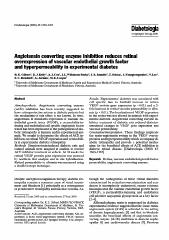Please use this identifier to cite or link to this item:
https://ahro.austin.org.au/austinjspui/handle/1/9281| Title: | Angiotensin converting enzyme inhibition reduces retinal overexpression of vascular endothelial growth factor and hyperpermeability in experimental diabetes. | Austin Authors: | Gilbert, Richard E;Kelly, D J;Cox, Allison J;Wilkinson-Berka, J L;Rumble, J R;Osicka, Tanya M;Panagiotopoulos, Sianna ;Lee, V ;Hendrich, E C;Jerums, George ;Cooper, Mark E | Affiliation: | University of Melbourne Department of Medicine, Austin and Repatriation Medical Centre, Victoria, Australia | Issue Date: | 1-Nov-2000 | Publication information: | Diabetologia; 43(11): 1360-7 | Abstract: | Angiotensin converting enzyme (ACE) inhibition has been recently suggested to have retinoprotective actions in diabetic patients but the mechanism of this effect is not known. In vitro, angiotensin II stimulates expression of vascular endothelial growth factor (VEGF), a permeability-inducing and endothelial cell specific angiogenic factor which has been implicated in the pathogenesis of diabetic retinopathy in humans and in experimental animals. We sought to determine the effects of ACE inhibition on retinal VEGF expression and permeability in experimental diabetic retinopathy.Streptozotocin-induced diabetic rats and control animals were assigned at random to receive ACE inhibitor treatment or vehicle. At 24 weeks the retinal VEGF protein gene expression was assessed by northern blot analysis and in situ hybridisation. Retinal permeability to albumin was measured using a double isotope technique.Experimental diabetes was associated with cell specific two to fourfold increase in retinal VEGF protein gene expression (p < 0.01) and a 2-fold increase in retinal vascular permeability to albumin (p < 0.01). The localization of VEGF expression in the retina was not altered in animals with experimental diabetes. Angiotensin converting enzyme inhibitor treatment of diabetic rats reduced diabetes-associated changes in VEGF gene expression and vascular permeability.These findings implicate the renin-angiotensin system in the VEGF overexpression and hyperpermeability which accompany diabetic retinopathy and provide a potential mechanism for the beneficial effects of ACE inhibition in diabetic retinal disease. | Gov't Doc #: | 11126403 | URI: | https://ahro.austin.org.au/austinjspui/handle/1/9281 | DOI: | 10.1007/s001250051539 | ORCID: | 0000-0002-0845-0001 | Journal: | Diabetologia | URL: | https://pubmed.ncbi.nlm.nih.gov/11126403 | Type: | Journal Article | Subjects: | Angiotensin II.physiology Angiotensin-Converting Enzyme Inhibitors.pharmacology Animals Blotting, Northern Capillary Permeability.drug effects Diabetes Mellitus, Experimental.physiopathology Diabetic Retinopathy.drug therapy.physiopathology Endothelial Growth Factors.genetics Gene Expression.drug effects In Situ Hybridization Lymphokines.genetics Male Perindopril.pharmacology RNA, Messenger.analysis Ramipril.pharmacology Rats Rats, Sprague-Dawley Retina.drug effects.metabolism Retinal Vessels.drug effects.physiopathology Vascular Endothelial Growth Factor A Vascular Endothelial Growth Factors |
| Appears in Collections: | Journal articles |
Files in This Item:
| File | Description | Size | Format | |
|---|---|---|---|---|
| 11126403.pdf | 198.46 kB | Adobe PDF |  View/Open |
Page view(s)
42
checked on Jan 21, 2025
Download(s)
108
checked on Jan 21, 2025
Google ScholarTM
Check
Items in AHRO are protected by copyright, with all rights reserved, unless otherwise indicated.
